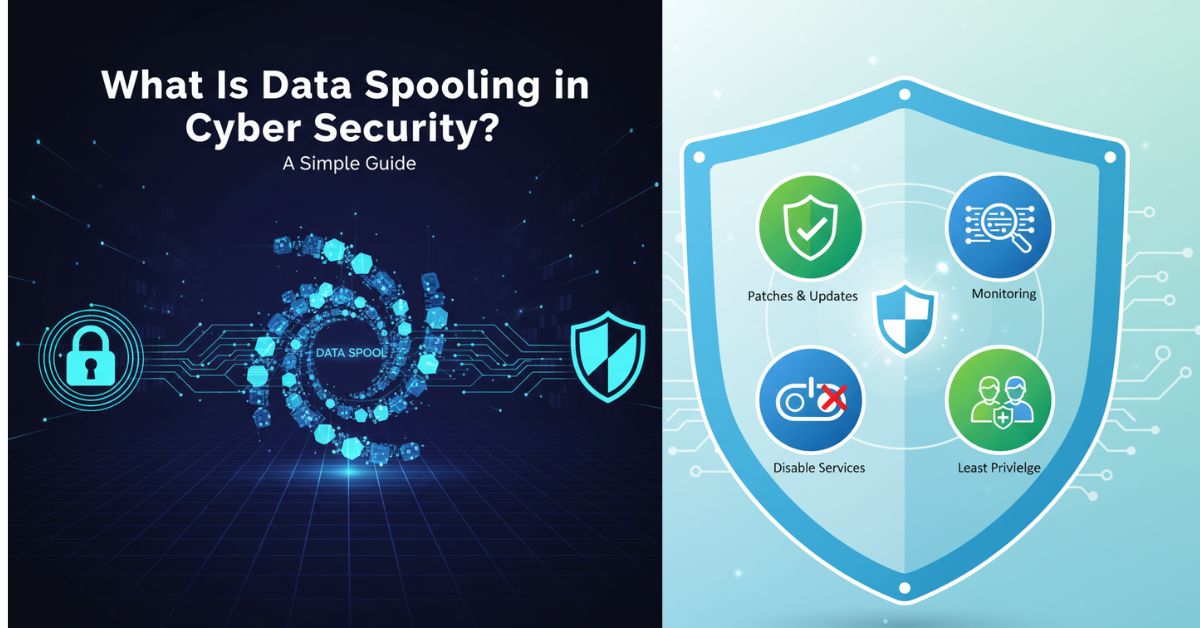Have you ever clicked “print” on a document and been able to continue working on your computer while the printer handles the job? That everyday convenience is thanks to a process called data spooling.
While this technology makes our digital lives smoother, it also introduces unique security risks that cyber criminals can exploit. Understanding what data spooling is and how to protect against related attacks is crucial for both individuals and organizations.
What Is Data Spooling?
Data spooling (which stands for “Simultaneous Peripheral Operations Online“) is a process where data is temporarily held in a waiting area—called a buffer or spool—before being processed or sent to a device . Think of it like a line at a coffee shop: customers place their orders (data) that go into a queue, and the barista (device) works through them one by one.
This temporary storage allows different parts of a system to work at their own pace without everything having to stop and wait. The most common example is print spooling, where documents are lined up to be printed in order .
How Does Spooling Work? The Step-by-Step Process
Spooling operates through a straightforward series of steps that manage data flow efficiently:
- Data Submission: When you send a task (like printing a document), your computer forwards the data to a temporary storage location called a spool or print queue .
- Queue Management: The spooling software organizes all incoming tasks in a line, typically following a “first-in, first-out” approach, similar to customers waiting in a queue .
- Background Processing: The spooler works in the background, sending data from the queue to the appropriate device when it’s ready. This frees up your computer so you can continue with other work .
- Completion: Once the data is successfully processed (like when your document finishes printing), it’s removed from the spool, and the system moves on to the next job in line .
Why Is Spooling a Target for Cyber Attacks?
Spooling systems present attractive targets for hackers for several key reasons:
- Temporary Data Storage: Spooling temporarily stores data, sometimes including sensitive documents or information, creating a potential treasure trove for attackers .
- Often Overlooked Security: Many devices that use spooling, like printers, aren’t always seen as security risks and may not have strong protection measures .
- Privileged Access: Spooler services sometimes have high-level system access, meaning if hackers compromise them, they might gain significant control over a system or network .
- Outdated Components: Some spooling software, like the Windows Print Spooler, contains very old code that may have unpatched vulnerabilities .
Common Types of Spooling Attacks
Cyber criminals employ various methods to exploit spooling systems:
Table: Common Spooling Attacks
Real-World Examples: PrintNightmare and Stuxnet
Two significant incidents highlight the serious real-world impact of spooling vulnerabilities:
- PrintNightmare: This critical vulnerability discovered in the Windows Print Spooler sent shockwaves through the security community in 2021. It allowed attackers to remotely run malicious code on target systems, potentially taking complete control of computers or networks. The incident demonstrated how a fundamental component used by nearly every Windows computer could become a major security threat .
- Stuxnet: This sophisticated cyber weapon, discovered in 2010, reportedly used a vulnerability in the Windows Print Spooler to help compromise Iran’s nuclear program. Even without an actual physical printer connected, the spooler service provided an entry point for the attack, showcasing how spooling vulnerabilities can be exploited in highly targeted operations .
How to Protect Against Spooling Attacks: Top Security Tips
Here are practical measures you can take to secure your systems against spooling attacks:
1. Keep Systems Updated
- Apply security patches promptly when they become available, especially for operating systems and printer firmware . Vendors regularly release fixes for known spooler vulnerabilities.
2. Implement Strong Access Controls
- Follow the principle of least privilege by restricting non-administrative users from installing printer drivers or modifying spooler settings .
- Use authentication requirements for printing, especially in office environments, to prevent unauthorized access to print queues .
3. Harden Your Spooling Systems
- Disable the Print Spooler service entirely on computers or servers that don’t actually need printing capabilities . This completely eliminates the attack vector for those devices.
- Turn off unnecessary services on devices like printers to reduce potential entry points for attackers .
4. Enhance Monitoring and Detection
- Monitor print spooler logs for suspicious activities, such as unexpected print jobs or unusual system behaviors .
- Use network monitoring tools to detect unusual traffic patterns that might indicate a spooling attack in progress .
5. Implement Additional Security Measures
- Use firewalls to control and filter traffic to and from devices that use spooling, like network printers .
- Encrypt sensitive documents before sending them to print, providing an extra layer of protection even if the data is intercepted .
Conclusion: Balancing Efficiency and Security
Data spooling is a fundamental computing process that provides significant efficiency benefits, allowing devices and systems to work together smoothly. However, this very functionality can create security vulnerabilities if not properly managed.
By understanding what data spooling is, recognizing its associated risks, and implementing practical security measures—like regular updates, access controls, and system monitoring—you can safely enjoy the benefits of spooling while protecting your systems and data from potential threats.











